Haryana State Board HBSE 10th Class Maths Solutions Chapter 3 Pair of Linear Equations in Two Variables Ex 3.2 Textbook Exercise Questions and Answers.
Haryana Board 10th Class Maths Solutions Chapter 3 Pair of Linear Equations in Two Variables Ex 3.2
Question 1.
Form the pair of linear equations in the following problems, and find their solutions graphically.
(i) 10 students of class X took part in a Mathematics quiz. If the number of girls is 4 more than the number of boys, find the number of boys and girls who took part in the quiz.
(ii) 5 pencils and 7 pens together cost ₹ 50, whereas 7 pencils and 5 pens together cost ₹ 46. Find the cost of one pencil and that of one pen.
Solution :
(i) Let the number of boys in the class be x and number of girls be y.
According to question,
x + y = 10 ……………..(1)
and y = x + 4
⇒ – x + y = 4 ……………(2)
∴ Linear equations are :
x + y = 10
– x + y = 4
Now, we draw the graphs of linear equations as follows :
x + y = 10
⇒ y = 10 – x
We put the different values of x in this equation, then we get different values of y and we prepare the table of x, y for equation x + y = 10

and – x + y = 4
y = 4 – x
We put the different values of x in this equation, then we get different values of y and we prepare the table of x, y for equation – x + y = 4


Now, we plot the points (2, 8), (5, 5) and (0, 10) on the graph paper and we draw a graph which passes through these points.
∴ We get a graph of a linear equation x + y = 10
Again, we plot the points (0, 4), (2, 6) and (- 1, 3) on the graph paper and we draw a graph which passes through these points.
∴ We get a graph of a linear equation – x + y = 4.
We observe that the graphs of the linear equations x + y = 10 and – x + y = 4, intersect each other at the point (3, 7). Hence x = 3, y = 7 is the solution of the linear equations.
Therefore, pair of linear equations is, x + y = 10, – x + y = 4 and number of boys = 3, and number of girls = 7.
(ii) Let the cost of 1 pencil be ₹ x
and the cost of 1 pen be ₹ y
According to question,
5x + 7y = 50 ……………………(1)
and 7x + 5y = 46 …………………..(2)
∴ Linear equations are:
5x + 7y = 50
7x + 5y = 46
Now, we draw the graphs of linear equations as follows :
5x + 7y = 50
⇒ 7y = 50 – 5x
⇒ y = \(\frac{50-5 x}{7}\)
We put the different values of x in this equation, then we get different values of y and we prepare the table of x, y for equation 5x + 7y = 50

and 7x + 5y = 46
5y = 46 – 7x
y = \(\frac{46-7 x}{5}\)
We put the different values of x in this equation, then we get different values of y and we prepare the table of x, y for equation 7x + 5y = 46

Now, we plot the points (3, 5), (10, 0), (- 4, 10) on the graph paper and we draw a graph which passes through these points.
∴ We get a graph of linear equation 5x + 7y = 50.
Again, we plot the points (8, – 2), (3, 5) and (- 2, 12) on the graph paper and we draw a graph which passes through these points.
∴ We get a graph of linear equation 7x + 5y = 46.
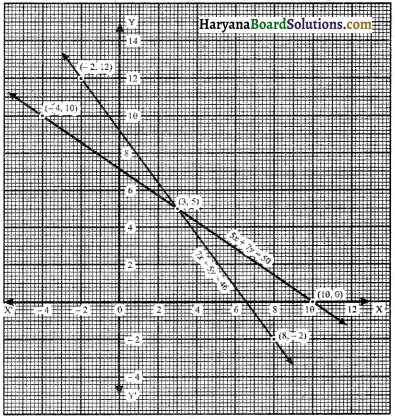
We observe that the graphs of equations 5x + 7y = 50, 7x + 5y = 46; intersect each other at point (3, 5). Hence, x = 3, y = 5 is the solution of linear equations.
Therefore, the pair of linear equations are :
5x + 7y = 50,
7x + 5y = 46
and the cost of 1 Pencil is ₹ 3 and the cost of 1 pen is ₹ 5.
Question 2.
On comparing the ratios \(\frac{a_1}{a_2}\), \(\frac{b_1}{b_2}\) and \(\frac{c_1}{c_2}\) find out whether the lines representing the following pairs of linear equations intersect at a point, are parallel or coincident:
(i) 5x – 4y + 8 = 0
7x + 6y – 9 = 0
(ii) 9x + 3y + 12 = 0
18x + 6y + 24 = 0
(iii) 6x – 3y + 10 = 0
2x – y + 9 = 0.
Solution :
(i) On comparing the linear equations 5x – 4y + 8 = 0, 7x + 6y – 9 = 0 with the general form of linear equations a1x + b1y + c1 = 0 and a2x + b2y + c2 = 0, we get
a1 = 5, b1 = – 4, c1 = 8, a2 = 1, b2 = 6, c2 = – 9
\(\frac{a_1}{a_2}=\frac{5}{7}\)
and \(\frac{c_1}{c_2}=\frac{8}{-9}=\frac{-8}{9}\)
Since, \(\frac{a_1}{a_2} \neq \frac{b_1}{b_2}\)
Therefore, the given lines intersect at a point.
(ii) On comparing the linear equations 9x + 3y + 12 = 0 and 18x + 6y + 24 = 0 with the general form of linear equations a1x + b1y + c1 = 0 and a2x + b2y + c2 = 0, we get
a1 = 9, b1 = 3, c1 = 12, a2 = 18, b2 = 6, c2 = 24
\(\frac{a_1}{a_2}=\frac{9}{18}=\frac{1}{2}\)
and \(\frac{c_1}{c_2}=\frac{12}{24}=\frac{1}{2}\)
Since, \(\frac{a_1}{a_2}=\frac{b_1}{b_2}=\frac{c_1}{c_2}\)
Therefore, the given lines are coincident lines.
(iii) On comparing the linear equations 6x – 3y + 10 = 0 and 2x – y + 9 = 0 with the general form of linear equations :
a1x + b1y + c1= 0
and a2x + b2y + c2 = 0, we get
a1 = 6, b1 = – 3, c1 = 10,
a2 = 2, b2 = – 1, c2 = 9
\(\frac{a_1}{a_2}=\frac{6}{2}\) = 3
\(\frac{b_1}{b_2}=\frac{-3}{-1}\) = 3
and \(\frac{c_1}{c_2}=\frac{10}{9}\)
Since, \(\frac{a_1}{a_2}=\frac{b_1}{b_2} \neq \frac{c_1}{c_2}\)
Therefore, the given lines are parallel lines.
Question 3.
On comparing the ratios \(\frac{a_1}{a_2}\), \(\frac{b_1}{b_2}\) and \(\frac{c_1}{c_2}\), find out whether the following pair of linear equations are consistent, or inconsistent:
(i) 3x + 2y = 5
2x – 3y = 7
(ii) 2x – 3y = 8
4x – 6y = 9
(iii) \(\frac{3}{2}\) x + \(\frac{5}{3}\) y = 7
9x – 10y = 14
(iv) 5x – 3y = 11
– 10x + 6y = – 22
(v) \(\frac{4}{3}\)x + 2y = 8
2x + 3y = 12.
Solution :
(i) We can write the given linear equations in the form of :
3x + 2y – 5 = 0
2x – 3y – 7 = 0
On comparing these equations with the general form of linear equations a1x + b1y + c1 = 0 and a2x + b2y + c = 0, we get
a1 = 3, b1 = 2, c1 = – 5, a2 = 2, b2 = – 3, c2 = – 7
Since, \(\frac{a_1}{a_2} \neq \frac{b_1}{b_2}\)
Therefore, the pair of linear equations has unique solution. So, the equations are consistent.
(ii) We can write the given linear equations in the form of :
2x – 3y – 8 = 0
4x – 6y – 9 = 0
On oemparing these equations with the general form of linear equations a1x + b1y + c1 = 0 and a2x + b2y + c2 = 0, we get
a1 = 2, b1 = – 3, c1 = – 8, a2 = 4, b2 = – 6, c2 = – 9
\(\frac{a_1}{a_2}=\frac{2}{4}=\frac{1}{2}\)
and \(\frac{c_1}{c_2}=\frac{-8}{-9}=\frac{8}{9}\)
Since, \(\frac{a_1}{a_2}=\frac{b_1}{b_2} \neq \frac{c_1}{c_2}\)
Therefore, the pair of linear equations are parallel lines. So, the equations are inconsistent.
(iii) We can write the given linear equations in the form of:
\(\frac{3}{2}\)x + \(\frac{5}{3}\)y – 7 = 0
9x – 10y – 14 = 0
On comparing these equations with the general form of linear equations a1x + b1y + c1 = 0 and a2x + b2y + c2 = 0, we get
a1 = \(\frac{3}{2}\), b1 = \(\frac{5}{3}\), c1 = – 7, a2 = 9, b2 = – 10, c2 = – 14
\(\frac{a_1}{a_2}=\frac{\frac{3}{2}}{9}=\frac{3}{2} \times \frac{1}{9}=\frac{1}{6}\)
Since \(\frac{a_1}{a_2} \neq \frac{b_1}{b_2}\)
Therefore, the pair of linear equations has a unique solution. So, the equations are consistent.
(iv) We can write the given linear equations in the form of:
5x – 3y – 11 = 0
– 10x + 6y + 22 = 0
On comparing these equations with the general form of linear equations a1x + b1y + c1 = 0 and a2x + b2y + c2 = 0, we get
a1 = 5, b1 = – 3, c1 = – 11, a2 = – 10, b2 = 6, c2 = 22
and \(\frac{c_1}{c_2}=-\frac{11}{22}=\frac{-1}{2}\)
Since, \(\frac{a_1}{a_2}=\frac{b_1}{b_2}=\frac{c_1}{c_2}\)
Therefore, the given linear equations are coincident lines. So, the equations are consistent.
(v) We can write the given linear equations in the form of:
\(\frac{4}{3}\)x + 2y – 8 = 0
2x + 3y – 12 = 0
On comparing these equations with the general form of linear equations a1x + b1y + c1 = 0 and a2x + b2y + c2 = 0, we get
a1 = \(\frac{4}{3}\), b1 = 2, c1 = – 8, a2 = 2, b2 = 3, c2 = – 12
and \(\frac{c_1}{c_2}=\frac{-8}{-12}=\frac{2}{3}\)
Since, \(\frac{a_1}{a_2}=\frac{b_1}{b_2}=\frac{c_1}{c_2}\)
Therefore, the given linear equations are coincident lines. So, the equations are consistent.
Question 4.
Which of the following pairs of linear equations are consistent/inconsistent? If consistent, obtain the solution graphically:
(i) x + y = 5
2x + 2y = 10
(ii) x – y = 8
3x – 3y = 16
(iii) 2x + y – 6 = 0
4x – 2y – 4 = 0
(iv) 2x – 2y – 2 = 0
4x – 4y – 5 = 0
Solution:
(i) We can write the given linear equations in the form of:
x + y – 5 = 0
2x + 2y – 10 = 0
On comparing these equations with the general form of linear equations a1x + by + c = 0 and ax + by + c = 0, we get
a1 = 1, b1 = 1, c1 = – 5, a2 = 2, b2 = 2, c2 = – 10
\(\frac{a_1}{a_2}=\frac{1}{2}\), \(\frac{b_1}{b_2}=\frac{1}{2}\)
and \(\frac{c_1}{c_2}=\frac{-5}{-10}=\frac{1}{2}\)
Since \(\frac{a_1}{a_2}=\frac{b_1}{b_2}=\frac{c_1}{c_2}\)
Therefore, the given linear equations are coincident lines. So, the equations are consistent.
Graphical solution :
We draw the graphs of given linear equations as follows:
x + y – 5 = 0
⇒ y = 5 – x
We put the different values of x in this equation then we get different values of y and we prepare the table of x, y for equation x + y – 5 = 0.

and 2x + 2y – 10 = 0
2y = 10 – 2x
⇒ y = \(\frac{10-2 x}{2}\)
⇒ y = 5 – x
The table of (x, y) for equation 2x + 2y – 10 = 0

Now, we plot the points (5, 0), (2, 3) and (1, 4) from table 1 and 2. Then we draw the graphs of linear equations x + y – 5 = 0 and 2x + 2y – 10 = 0 which passes through these points.
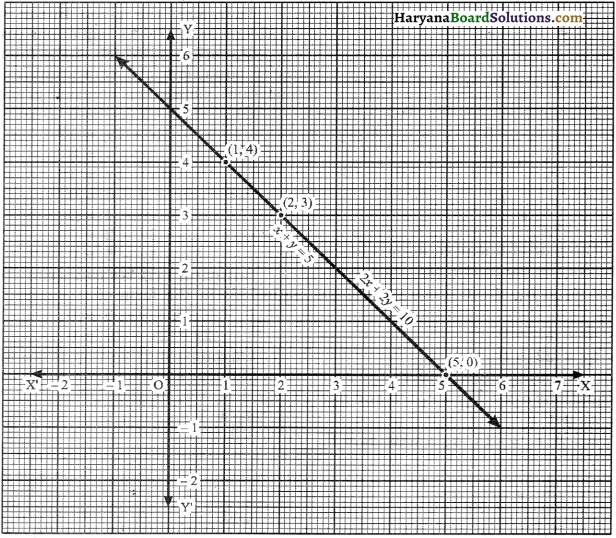
We observe that the graphs of linear equations are coincident lines which overlap each other so, it has infinitely manv solutions. Solutions are (5, 0), (2, 3) and (1, 4).
(ii) We can write the given linear equations in the form of :
x – y – 8 = 0
3x – 3y – 16 = 0
On comparing these equations with the general form of linear equations a1x + b1y + c1 = 0 and a2x + b2y + c2 = 0, we get
a1 = 1, b1 = – 1, c1 = – 8, a2 = 3, b2 = – 3, c2 = – 16
\(\frac{a_1}{a_2}=\frac{1}{3}\), \(\frac{b_1}{b_2}=\frac{-1}{-3}=\frac{1}{3}\)
and \(\frac{c_1}{c_2}=\frac{-8}{-16}=\frac{1}{2}\)
Since, \(\frac{a_1}{a_2}=\frac{b_1}{b_2} \neq \frac{c_1}{c_2}\)
Therefore, the given linear equations are parallel lines. So, the equations are inconsistent.
(iii) On comparing the linear equations 2x + y – 6 = 0 and 4x – 2y – 4 = 0 with the general form oflinear equations a1x + b1y + c1 = 0 and a2x + b2y + c2 = 0, we get
a1 = 2, b1 = 1, c1 = – 6, a2 = 4, b2 = – 2, c2 = – 4
\(\frac{a_1}{a_2}=\frac{2}{4}=\frac{1}{2}\),
and \(\frac{c_1}{c_2}=\frac{-6}{-4}=\frac{3}{2}\)
Since, \(\frac{a_1}{a_2} \neq \frac{b_1}{b_2}\)
Therefore, the given linear equations intersect each other at a point. So, the equations are consistent.
Graphical solution :
We draw the graphs of linear equations as follows :
2x + y – 6 = 0
⇒ y = 6 – 2x
We put the different values of x in this equation then we get different values of y and we prepare the table of x, y.

and 4x – 2y – 4 = 0
⇒ 2y = 4x – 4
⇒ y = \(\frac{4 x-4}{2}\)
y = 2x – 2
We put the different values of x in this equation, then we get different values of y and we prepare the table of x, y.
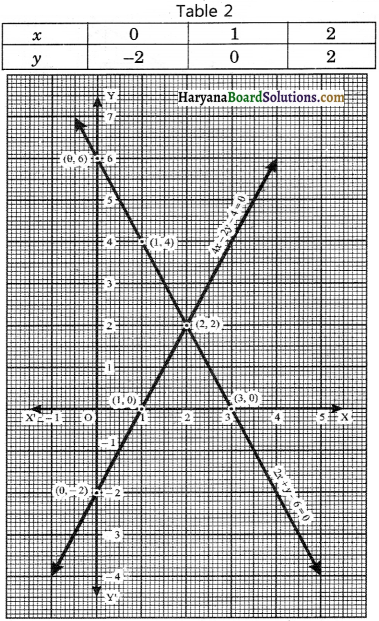
Therefore, the given linear equations are coincident lines. So, the equations are consistent.
Now, we plot the points (0, 6), (1, 4) and (3, 0) on the graph paper and we draw a graph which passes through these points.
∴ We get a graph of linear equation 2x + y – 6 = 0.
Again, we plot the points (0, – 2), (1, 0) and (2, 2) on the graph paper and we draw a graph which passes through these points.
∴ We get a graph of linear equation 4x – 2y – 4 = 0.
We observe that the graphs of linear equations 2x + y – 6 = 0 and 4x – 2y – 4 = 0 intersect each other at point (2, 2). Hence, x = 2, y = 2 is the solution of the given linear equations.
(iv) On comparing the linear equations 2x – 2y – 2 = 0 and 4x – 4y – 5 = 0, with the general form of linear equations a1x + b1y + c1 = 0 and a2x + b2y + c2 = 0, we get
a1 = 2, b1 = – 2, c1 = – 2, a2 = 4, b2 = – 4, c2 = – 5
\(\frac{a_1}{a_2}=\frac{2}{4}=\frac{1}{2}\)
and \(\frac{c_1}{c_2}=\frac{-2}{-5}=\frac{2}{5}\)
Since, \(\frac{a_1}{a_2}=\frac{b_1}{b_2} \neq \frac{c_1}{c_2}\)
Therefore, the given linear equations are parallel lines. So, the equations are inconsistent.
Question 5.
Half the perimeter of a rectangular garden, whose length is 4 m more than its width, is 36 m. Find the dimensions of the garden.
Solution:
Let the length of rectangular garden be x m and width be y m.
According to question,
\(\frac{2(x+y)}{2}\) = 36
x + y = 36 …………………(1)
and x = y + 4
⇒ x – y = 4 ……………….(2)
We draw the graphs of these equations as follows :
x + y = 36
⇒ y = 36 – x
We put the different values of x in this equation then we get different values of y and we prepare the table of x, y for equation x + y = 36

x – y = 4
⇒ y = x – 4
We put the different values of x in this equation then we get different values of y and we prepare the table of x, y for equation x – y = 4

Now, we plot the points (10, 26), (20, 16) and (12, 24) on the graph paper and we draw a graph which passes through these points.
∴ We get a graph of linear equation x + y = 36.
Again, we plot the points (20, 16), (2, – 2) and (4, 0) on the graph paper and we draw a graph which passes through these points.
∴ We get a graph of linear equation x – y = 4.
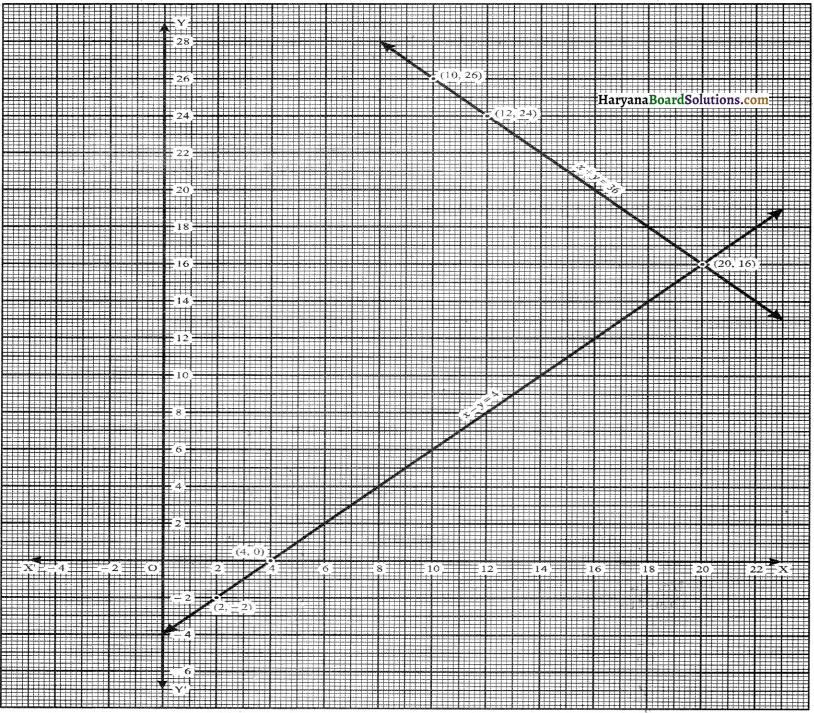
We observe that the graphs of linear equations x + y = 36 and x – y =4 intersect each other at point (20, 16). Hence, x = 20, y = 16 is the solution of given linear equations.
Therefore, Length of garden = 20 m
Width of garden = 16 m.
Question 6.
Given the linear equation 2x + 3y – 8 = 0, write another linear equation in two variables such that the geometrical representation of the pair so formed is :
(i) intersecting lines
(ii) parallel lines
(iii) coincident lines.
Solution :
On comparing the given linear equation 2x + 3y – 8 = 0 with the general form of linear equation ax + by + c = 0, we get
a = 2, b = 3, c = – 8
(i) When a pair of linear equations are intersecting lines, then condition is :
\(\frac{a_1}{a_2} \neq \frac{b_1}{b_2}\)
⇒ \(\frac{2}{a_2} \neq \frac{3}{b_2}\)
⇒ \(\frac{a_2}{b_2} \neq \frac{2}{3}\)
Hence, required possible another linear equation is 3x + 2y – 10 = 0.
(ii) When a pair of linear equations are parallel lines, then condition is :
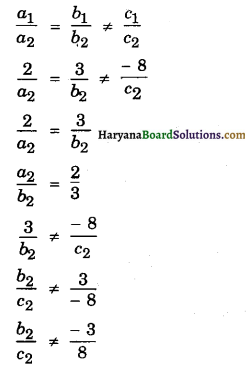
Hence, required possible another linear equation is 2x + 3y – 12 = 0.
(iii) When the pair of linear equations are coincident lines, then the condition is :
\(\frac{a_1}{a_2}=\frac{b_1}{b_2}=\frac{c_1}{c_2}\)
Let \(\frac{a_2}{2}=\frac{b_2}{3}=\frac{c_2}{-8}\) = k [Where k is constant]
a2 = 2k
b2 = 2k
and c2 = – 8k
Hence, the required linear equation is : 2kx + 3ky – 8k = 0 [Where k is constant].
Therefore, the required possible linear equation is 4x + 6y – 16 = 0.
Question 7.
Draw the graphs of the equations x – y + 1 = 0 and 3x + 2y – 12 = 0. Determine the coordinates of the vertices of the triangle formed by these lines and the x- axis and shade the triangular region.
Solution:
We draw the graph of given linear equations as follows :
x – y + 1 = 0
y = x + 1
We put the different values of x in this equation, then we get different values of y and we prepare the table of x, y for equation x – y + 1 = 0

and 3x + 2y – 12 = 0
⇒ 2y = 12 – 3x
⇒ y = \(\frac{12-3 x}{2}\)

We put the different values of x m this equation then we get different values of y and we prepare the table of x, y for equation 3x + 2y – 12 = 0
Now, we plot the points (2, 3), (4, 5) and (5, 6) on the graph paper and we draw a graph which passes through these points.
∴ We get a graph of linear equation x – y + 1 = 0.
Again, we plot the points (0, 6), (2, 3) and (4,0) on the graph paper and we draw a graph, which passes through these points.
∴ We get a graph of linear equation 3x + 2y – 12 = 0.
